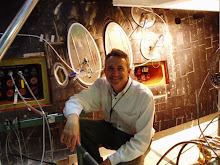 Cp is not measured directly but is calculated from the pitching moment and normal force acting on a vehicle in flight. We used an 8% scale model of the MLAS flight vehicle in the Calspan 8-foot Transonic Wind Tunnel to collect force and moment data. A model component build-up approach was used in testing which allowed us to derive the longitudinal and lateral forces and moments contributed by each model component. The wind tunnel model was itself a work of art: a precision instrument, milled from solid aluminum blocks, with stainless steel fins. This replica of the flight vehicle could be assembled and oriented as desired to test each of the three separate flight configurations: boost, coast and reorientation. A clever system of access hatches and a rotatable sting mount allowed the reorientation configuration to be tested at all pitch angles between 0 and 180 degrees. The model is shown here mounted on the Calspan tunnel's test apparatus. Data gathered in the tunnel was nearly identical to that predicted by CFD and ultimately used to fix position of the MLAS Cp in the boost configuration and zero angle of attack at X=180.5 in ... slightly forward of the Coast Skirt's center.
Cp is not measured directly but is calculated from the pitching moment and normal force acting on a vehicle in flight. We used an 8% scale model of the MLAS flight vehicle in the Calspan 8-foot Transonic Wind Tunnel to collect force and moment data. A model component build-up approach was used in testing which allowed us to derive the longitudinal and lateral forces and moments contributed by each model component. The wind tunnel model was itself a work of art: a precision instrument, milled from solid aluminum blocks, with stainless steel fins. This replica of the flight vehicle could be assembled and oriented as desired to test each of the three separate flight configurations: boost, coast and reorientation. A clever system of access hatches and a rotatable sting mount allowed the reorientation configuration to be tested at all pitch angles between 0 and 180 degrees. The model is shown here mounted on the Calspan tunnel's test apparatus. Data gathered in the tunnel was nearly identical to that predicted by CFD and ultimately used to fix position of the MLAS Cp in the boost configuration and zero angle of attack at X=180.5 in ... slightly forward of the Coast Skirt's center.Scaling for µMLAS puts the tunnel predicted CP 10.36" from the tip of the model's nose. Interestingly, RockSim's stability equations put it at 10.28" ... very close, and well within the margin of error for the tunnel predictions. Of course, this could just be coincidental -- one data point is hardly enough to validate a piece of software -- but it gave me a warm fuzzy feeling about RockSim. And at $120, RockSim was significantly less expensive than those wind tunnel tests.







